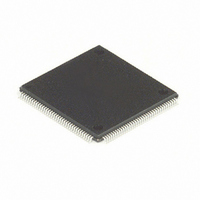MC68HC16Z1CAG25 Freescale Semiconductor, MC68HC16Z1CAG25 Datasheet - Page 99

MC68HC16Z1CAG25
Manufacturer Part Number
MC68HC16Z1CAG25
Description
IC MCU 16BIT 25MHZ 144-LQFP
Manufacturer
Freescale Semiconductor
Series
HC16r
Datasheet
1.MC68HC16Z1VEH16.pdf
(500 pages)
Specifications of MC68HC16Z1CAG25
Core Processor
CPU16
Core Size
16-Bit
Speed
25MHz
Connectivity
EBI/EMI, SCI, SPI
Peripherals
POR, PWM, WDT
Number Of I /o
16
Program Memory Type
ROMless
Ram Size
1K x 8
Voltage - Supply (vcc/vdd)
2.7 V ~ 5.5 V
Data Converters
A/D 8x10b
Oscillator Type
Internal
Operating Temperature
-40°C ~ 85°C
Package / Case
144-LQFP
Cpu Family
HC16
Device Core Size
16b
Frequency (max)
25MHz
Interface Type
SCI/SPI/UART
Program Memory Size
Not Required
Total Internal Ram Size
1KB
# I/os (max)
16
Number Of Timers - General Purpose
11
Operating Supply Voltage (typ)
3.3/5V
Operating Supply Voltage (max)
5.5V
Operating Supply Voltage (min)
2.7V
On-chip Adc
8-chx10-bit
Instruction Set Architecture
CISC
Operating Temp Range
-40C to 85C
Operating Temperature Classification
Industrial
Mounting
Surface Mount
Pin Count
144
Package Type
LQFP
Controller Family/series
68HC16
No. Of I/o's
16
Ram Memory Size
1KB
Cpu Speed
25MHz
No. Of Timers
2
Embedded Interface Type
QSPI, SCI
Rohs Compliant
Yes
Processor Series
HC16Z
Core
CPU16
Data Bus Width
16 bit
Data Ram Size
1 KB
Maximum Clock Frequency
25 MHz
Number Of Programmable I/os
16
Number Of Timers
11
Maximum Operating Temperature
+ 85 C
Mounting Style
SMD/SMT
Minimum Operating Temperature
- 40 C
Lead Free Status / RoHS Status
Lead free / RoHS Compliant
Eeprom Size
-
Program Memory Size
-
Lead Free Status / Rohs Status
Compliant
Available stocks
Company
Part Number
Manufacturer
Quantity
Price
Company:
Part Number:
MC68HC16Z1CAG25
Manufacturer:
FREESCAL
Quantity:
455
Company:
Part Number:
MC68HC16Z1CAG25
Manufacturer:
Freescale Semiconductor
Quantity:
10 000
- Current page: 99 of 500
- Download datasheet (6Mb)
4.13.3 Exception Processing Sequence
4.13.4 Types of Exceptions
4.13.4.1 Asynchronous Exceptions
4.13.4.2 Synchronous Exceptions
M68HC16 Z SERIES
USER’S MANUAL
Exception processing is performed in four phases. Priority of all pending exceptions is
evaluated and the highest priority exception is processed first. Processor state is
stacked, then the CCR PK extension field is cleared. An exception vector number is
acquired and converted to a vector address. The content of the vector address is load-
ed into the PC and the processor jumps to the exception handler routine.
There are variations within each phase for differing types of exceptions. However, all
vectors except RESET are 16-bit addresses, and the PK field is cleared during excep-
tion processing. Consequently, exception handlers must be located within bank 0 or
vectors must point to a jump table in bank 0.
Exceptions can be either internally or externally generated. External exceptions, which
are defined as asynchronous, include interrupts, bus errors, breakpoints, and resets.
Internal exceptions, which are defined as synchronous, include the software interrupt
(SWI) instruction, the background (BGND) instruction, illegal instruction exceptions,
and the divide-by-zero exception.
Asynchronous exceptions occur without reference to CPU16 or IMB clocks, but excep-
tion processing is synchronized. For all asynchronous exceptions except RESET, ex-
ception processing begins at the first instruction boundary following recognition of an
exception. Refer to
cerning asynchronous exceptions.
Because of pipelining, the stacked return PK : PC value for all asynchronous excep-
tions, other than reset, is equal to the address of the next instruction in the current in-
struction stream plus $0006. The RTI instruction, which must terminate all exception
handler routines, subtracts $0006 from the stacked value to resume execution of the
interrupted instruction stream.
Synchronous exception processing is part of an instruction definition. Exception pro-
cessing for synchronous exceptions is always completed, and the first instruction of
the handler routine is always executed, before interrupts are detected.
Because of pipelining, the value of PK : PC at the time a synchronous exception exe-
cutes is equal to the address of the instruction that causes the exception plus $0006.
Because RTI always subtracts $0006 upon return, the stacked PK : PC must be ad-
justed by the instruction that caused the exception so that execution resumes with the
following instruction. For this reason, $0002 is added to the PK : PC value before it is
stacked.
5.8.1 Interrupt Exception Processing
Freescale Semiconductor, Inc.
For More Information On This Product,
CENTRAL PROCESSING UNIT
Go to: www.freescale.com
for more information con-
4-39
Related parts for MC68HC16Z1CAG25
Image
Part Number
Description
Manufacturer
Datasheet
Request
R
Part Number:
Description:
Manufacturer:
Freescale Semiconductor, Inc
Datasheet:
Part Number:
Description:
Manufacturer:
Freescale Semiconductor, Inc
Datasheet:
Part Number:
Description:
Manufacturer:
Freescale Semiconductor, Inc
Datasheet:
Part Number:
Description:
Manufacturer:
Freescale Semiconductor, Inc
Datasheet:
Part Number:
Description:
Manufacturer:
Freescale Semiconductor, Inc
Datasheet:
Part Number:
Description:
Manufacturer:
Freescale Semiconductor, Inc
Datasheet:
Part Number:
Description:
Manufacturer:
Freescale Semiconductor, Inc
Datasheet:
Part Number:
Description:
Manufacturer:
Freescale Semiconductor, Inc
Datasheet:
Part Number:
Description:
Manufacturer:
Freescale Semiconductor, Inc
Datasheet:
Part Number:
Description:
Manufacturer:
Freescale Semiconductor, Inc
Datasheet:
Part Number:
Description:
Manufacturer:
Freescale Semiconductor, Inc
Datasheet:
Part Number:
Description:
Manufacturer:
Freescale Semiconductor, Inc
Datasheet:
Part Number:
Description:
Manufacturer:
Freescale Semiconductor, Inc
Datasheet:
Part Number:
Description:
Manufacturer:
Freescale Semiconductor, Inc
Datasheet:
Part Number:
Description:
Manufacturer:
Freescale Semiconductor, Inc
Datasheet:











